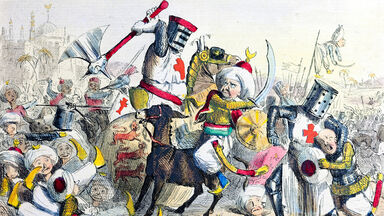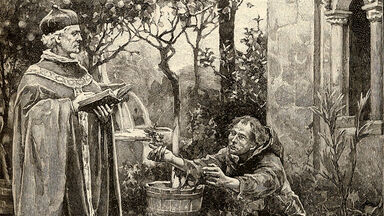How Long Were The Crusades
Crusades Timeline: Examining How Long It Lasted
You lot may accept heard of the Crusades of the Medieval menses, but what were they? How long did the Crusades last, and why were they fought in the showtime place? Keep reading for a Crusades timeline that includes the major events and key historical leaders of these holy wars.
 crusades Richard the Lionheart
crusades Richard the Lionheart
The Holy Land Crusades
The Crusades for the Holy State lasted nearly 200 years, taking place between 1096 and 1291. They were a series of religious wars betwixt Christians and Muslims during the Middle Ages. All told, there were nine separate wars for control over the Holy Land (or Levant), ending in major power shifts, holy territory exchanges and over one meg lives lost.
Historical Groundwork of the Crusades
During the loftier Heart Ages, the spread of Islam coincided with the expansion of the Holy Roman Empire. Both religious forces had powerful militaries and a want to control the Holy Land — namely, Jerusalem. The Holy Land had been under the command of the Roman Empire (then the Byzantine Empire) for over 500 years.
By the kickoff of the 11th century, the Byzantine Empire controlled most of the Heart Eastern territory between the Cosmic Church's command in Western Europe and the Muslim armies of key Asia. However, Seljuk Turks from Asia had been invading Byzantine countries for decades, taking over Persia, Armenia, Iraq, and eventually Jerusalem earlier 1070. In 1095, Emperor Alexius I of the Byzantine Empire petitioned for help against the Turks, and Pope Urban II declared the Holy Roman Empire'south intention to have back the Holy Land at the 1095 Council of Clermont.
The First Crusade (1096-1099)
An army of Crusaders, mostly containing knights and European infantry, marched toward Asia Modest in 1096. By 1097, the Crusaders took Nicaea of the Holy Land from the Turks and later took Antioch in a encarmine massacre. They reached Jerusalem in 1099, killed tens of thousands of citizens, and captured the metropolis. The First Crusade ended in a victory for the Christians and the Holy Roman Empire, every bit Jerusalem was in their control. They established the Kingdom of Jerusalem to serve equally the stronghold of the Latin Middle East.
The Second Crusade (1147-1149)
Nearly fifty years later, the Crusaders rode once again confronting the Muslim Turks. The metropolis of Edessa, which had previously been in Christian control, had been taken past the Muslims in 1144. Pope Eugenius III chosen for a second cause a twelvemonth after, and Conrad III (rex of Germany) and Louis 7 (king of France) took upward the cross in 1147, pregnant that they agreed to lead the Crusade. The Crusaders clashed with the Byzantine forces at Constantinople earlier being defeated by the Turks in Asia Minor. A poorly planned siege at Damascus ended the Second Crusade as a loss for the Christians.
The 3rd Crusade (1189-1192)
The failure of the Second Crusade emboldened the Muslims against the Christians, who now seemed weak. A unified Muslim country led past Saladin, Sultan of Egypt, took Christian-held Jerusalem in 1187. Pope Gregory 8 called for the 3rd Crusade shortly after, and King Frederick I of Federal republic of germany and the Holy Roman Empire, Male monarch Philip II of France, and King Richard I of England set off on what would exist known as the Kings' Crusade. began two years after as an effort to accept the city dorsum.
Frederick I died shortly after the Crusade began, and Philip II returned to France in 1191, but Richard I successfully took the cities of Cyprus, Acre and Jaffa before returning to England in 1192. The Crusaders never reached Jerusalem, and it remained in Muslim control.
The Quaternary Crusade (1202-1204)
The Crusaders set out once again in 1202 to retake Jerusalem in the Fourth Crusade, by call of Pope Innocent 3. Withal, the years of strife and mistrust between the Holy Roman Empire and the Byzantine Empire led to significant clashes between the Crusaders and Byzantine citizens. In 1204, the Crusaders sacked and looted Constantinople, the capital of the Byzantine Empire and their previous allies. The remainder of the Byzantine Empire was divided by the Latin Empire. A few Crusaders somewhen reached Jerusalem only failed to retake it.

The 5th Crusade (1217-1221)
In another attempt to capture Jerusalem, Western Europe began the Fifth Cause against the Muslims. The Crusade was again chosen by Pope Innocent III. Rather than become through Byzantium to the Holy Country, the Crusaders attempted to weaken Muslim forces by taking Damietta and Cairo from al-Kamil, Sultan of Egypt, outset. Subsequently breaching Damietta in an all-encompassing entrada, the Christians rejected Egypt'southward peace offer of control of Jerusalem and took Damietta instead. Even so, the campaign to take Cairo concluded in defeat and withal no control over Jerusalem.
The Sixth Crusade (1228-1229)
Many historians consider the Sixth Crusade to be a continuation of the Fifth Crusade, as its aftermath accomplished the goals of the previous (and unsuccessful) Crusade. Holy Roman Emperor Frederick Ii's spousal relationship to Isabella II and the birth of son Conrad fabricated him leader of the Kingdom of Jerusalem, the Christian holdings in the Latin Middle Eastward, and gave him new inspiration to take dorsum the metropolis once and for all. His Crusaders marched on the Holy Land, and in 1229, Frederick II negotiated the Treaty of Jaffa. It gave Christians chief command of Jerusalem in substitution for the protection of Muslim interests and a 10-yr truce.
The Seventh Crusade (1248-1254)
Jerusalem was taken by the Khwarismians in 1244 in a violent siege, and the Christians besides lost territory to Egyptian sultan al-Salih Ayyub. Pope Innocent IV chosen for the Seventh Crusade shortly later, and Male monarch Louis IX of France began a well-funded (primarily from pillaging wealth and property from French Jews) campaign in 1248. When the Crusaders arrived in Egypt, they took Damietta but failed to progress by the city of Mansourah. Louis Nine was captured during the Crusaders' surrender and released after paying a ransom and giving upward the metropolis of Damietta. It was the about expensive Crusade to date and ended with Muslims maintaining command over Jerusalem.
The 8th Crusade (1270)
King Louis Nine was not finished with the life of being a Crusader. After fortifying Christian strongholds in the Latin Center Eastward (primarily the city of Acre), he again set off in the Eighth Crusade to retake Jerusalem. This time, he would focus on Tunis as a more strategic identify to assail Egypt and conquer Jerusalem. Notwithstanding, Louis IX and his son died of dysentery but a month into the entrada, and the Crusade was abandoned. Louis Ix was later canonized as a saint for his devotion to the Church.

The Ninth Crusade (1271-1272)
Often seen as the continuation of the Eighth Crusade, the 9th Crusade (known every bit Lord Edward'south Cause) picked up a year later with Lord Edward of England, who had participated in the Eighth Crusade and would later become King Edward I. The Crusaders arrived in Acre to defend it from Baibars, the new Sultan of Arab republic of egypt. Edward fabricated it to the Holy State and joined with Hugh, Rex of Jerusalem, to negotiate a truce for 10 years, 10 months and 10 days with Baibars, but no Christian reoccupation of the Holy Land. The final Cause for the Holy Land was finished.
The Autumn of Acre (1291)
Later on the 9th Crusade, the Christian-held city of Acre (the performance capital letter of the Kingdom of Jerusalem) fell to the Egyptian army, known as the Mamluks. The siege brought much commemoration to the Muslim world every bit the city was the only major presence of the Latin Centre Due east exterior of Cyprus. With the fall of Acre, the Christians gave up whatsoever aims on Jerusalem. While time to come crusades in the 14th century blocked the advancing Turks from Roman territory, the Holy Roman Empire would never once again effort to take the Holy Land, later known equally Palestine.
The Popular Crusades
The nine official wars of the Crusades timeline were ordered and directed past political leaders, monarchs and popes throughout Europe. However, in that location was also a series of peasant crusades and movements of unrest that were inspired by the pro-Crusades rhetoric at the time. These crusades involved commoners who were driven by religious fervor, poverty and acrimony at their own monarchies to form armies that ranged from weakly untrained to violently anarchic.
- The People'south Cause (1096) - Also known as the Peasants' Cause, it consisted of an untrained but enthusiastic army of peasants led by Peter the Hermit and concluded in a surprise assault by the Turks.
- The Children's Cause (1212) - Between the Fourth and Fifth Crusades, Stephen of Cloyes and Nicholas of Cologne, both young boys at the fourth dimension, persuaded tens of thousands of children and adults to march into Jerusalem and convert the Muslims. Near of the crusaders died of starvation or were sold into slavery, and others headed back home before reaching Jerusalem.
- The Shepherds' Cause (1251) - When Rex Louis 9 of French republic was captured in the Seventh Crusade, a movement began in France to revolt against the Church and its inability to save the rex. Over fifty,000 shepherds and peasants attacked priests and churches throughout France before being excommunicated by the queen.
- The Cause of the Poor (1309) - After the fall of Acre in 1291, peasants from Western Europe responded to a call by Pope Clement V to begin another Crusade. Though the official 10th crusade would never begin, the poor crusaders formed their ain army just could not make it past Avignon without assistance from the Pope, who did not sanction their crusade.
- The Shepherds' Crusade (1320) - Similar the Shepherds' Cause of 1251, this unofficial crusade was led by a group of French shepherds and peasants. Their goal was to fight alongside Christians in Iberia, but almost of their tactics involved attacking and killing French Jews, who had only been allowed back in the country for a few years after being expelled in 1306.
The Clash of World Religions
The Crusades represent a menstruum in earth history where the two largest religions in the world competed for the same coveted space. They set the stage for religious discrimination for years to come up, and one tin still hear echoes of these devastating battles in our modern world. Learn more near the basic beliefs of world religions to understand the religious context of the Crusades, and why and so many men, women and children were willing to dice for their faith.
Source: https://examples.yourdictionary.com/crusades-timeline-examining-how-long-it-lasted
Posted by: naronunatesures.blogspot.com



0 Response to "How Long Were The Crusades"
Post a Comment